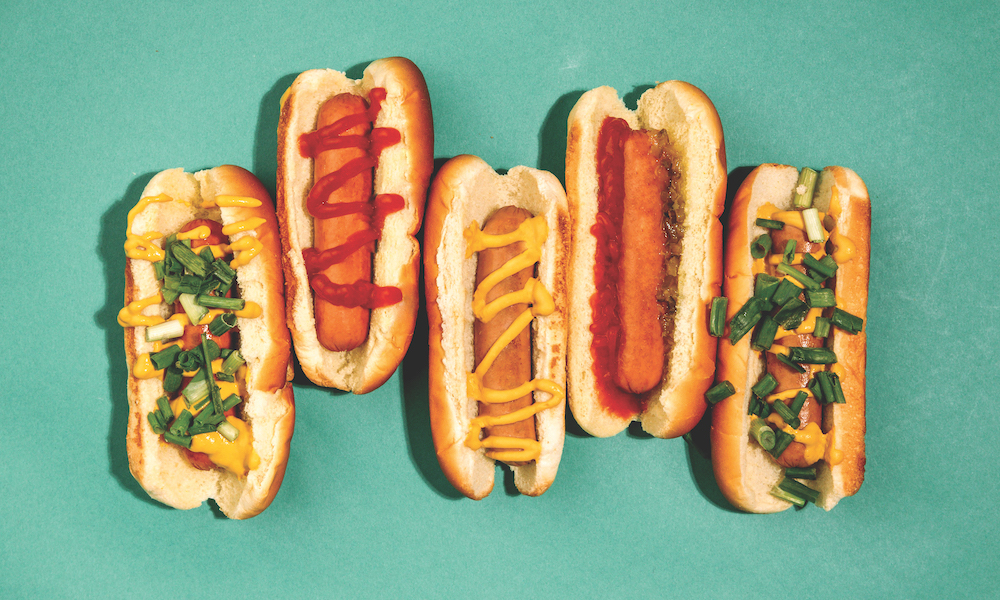
Is the hot dog a Jewish food? Frankly, it depends on how you slice it. Sausages—ground and salted meat mixed with spices and preserved in a distinctly phallic shape—have been around for millennia. Homer sang of them in the Odyssey, and Emperor Nero’s cook Gaius was known to make them as well. By the 14th century, sausages had migrated to Central Europe, where regional varieties—such as the frankfurters of Frankfurt and the wieners of Vienna—took form.
In the 1800s, Austrian immigrants brought wieners with them to New York City’s Lower East Side, that veritable meat grinder (forget melting pot) of cultures and cuisines. Sausage peddlers on America’s city streets became known as “wienerwurst men” (“wurst” being German for sausage) and were considered something of a nuisance. “He is the creature whose yells make night hideous, and whose wares make dreams that poison sleep,” began a Nashville newspaper’s 1886 characterization of the wienerwurst vendor. Hasia Diner, professor emerita of history at New York University, says that many merchants and storekeepers “were annoyed by the noise and the smells and the crowding on the street corners around all sorts of food vendors,” including the wienerwurst men.
It’s not clear how or why frankfurters and wienerwursts became hot dogs. The main technical difference is that the meat isn’t just ground, like in sausage, but emulsified. Regarding the name, the National Hot Dog and Sausage Council (NHDSC) (which, yes, exists) suggests that frankfurter vendors called their long, thin offerings Dachshund sausages, referring to their resemblance to the German dog bred to chase badgers and other burrow-dwelling creatures. From Dachshund sausage, it could have been but a short hop to “dogs,” then hot dog. (Of course, in what surely must be a bitterly ironic twist of fate for the proud Dachshund, their breed has now become known to many as wiener dogs.) An alternative theory is that hot dogs were assumed to be made from, among other things, dog meat.
It didn’t take long for Jewish immigrants—many of whom would have learned about German sausages from their neighbors on New York’s Lower East Side—to horn in on the hot dog scene. Charles Feltman, a German Jew, opened the first hot dog cart at Coney Island in the 1870s and eventually expanded to a full-service restaurant. Food writer June Hersh explains that Feltman, dubbed “Inventor of the Hot Dog” by the Coney Island History Project, funded an “empire” in Coney Island owing to his early years of selling hot dogs from his pushcart.
But to the masses, Coney Island hot dogs will always be associated with a different Jewish immigrant. In 1912, a few years after Feltman’s death, his restaurant hired Nathan Handwerker, a Polish Jew, as a grill-and-bun worker. According to Hersh, Handwerker saved $300 working at Feltman’s, quit the restaurant and—along with his wife, Ida—began selling hot dogs from his own pushcart in Coney Island in 1916. His hot dogs (which were Ida’s family recipe) sold for half the price of Feltman’s. “With Nathan Handwerker, the hot dog becomes a thing,” notes Katharina Vester, professor of history and American Studies at American University. This would eventually prove fateful for countless rest stops across America.

A crowd eating and drinking at Nathan’s food counter on Coney Island, July 1947. (Photo credit: LOC)
While Handwerker’s business grew rapidly, many customers were concerned—rightly—that a hot dog that cost only five cents might be unhealthy. According to Hersh, Handwerker got around that by offering free hot dogs to the doctors and nurses who worked at Coney Island hospital. “The perception became ‘Well, if these doctors and nurses in their white lab coats are at the stand, these must be really good for you.’” Another version of the story is that Handwerker simply hired people to dress up as medical professionals.
Handwerker also hit upon another marketing ploy—he promoted his hot dogs as “kosher-style,” meaning all-beef, but lacking the rabbinical kosher certification, or hechsher. Handwerker’s “kosher-style” dogs attracted some Jews who had kept kosher before coming to America, but more notably, non-Jews who assumed that kosher hot dogs were higher quality than non-kosher ones. (Hebrew National, founded in 1905, followed a similar path of capitalizing on customers’ desires for a product perceived as better quality. They adopted their famous slogan, “We answer to a higher authority,” in 1965, although how kosher their meat really is has been subject to controversy and lawsuits.) The term “kosher-style” has become mainstream in recent decades, but originated with Handwerker on the Coney Island boardwalk.
Hot dogs also inspired another of America’s most enduring marketing gimmicks—Oscar Meyer’s Wienermobile. The first Weinermobile was created in 1936, but college-age “hotdoggers” continue to roll around the country for “meat and greets” to promote their product. Fun fact: Former House Speaker Paul Ryan once drove the wienermobile while interning for Oscar Meyer in college.
Hot dogs have also become inextricably tied to America’s favorite pastime—baseball. One story goes that a German immigrant named Chris von der Ahe, owner of the St. Louis Browns, began selling hot dogs at the stadium in 1893, inspiring other owners to replicate his move. Another story has it that Harry M. Stevens, an English immigrant in Ohio, fell in love with baseball and quickly recognized the need for snacks at the games. After Stevens’ death, one eulogist called him “the man who gave fame to the hot dog.” Regardless, by 1939 hot dogs had become so American that President Roosevelt served them to England’s King George VI at an Independence Day celebration (according to The New York Times, George asked for seconds).
Today, around 19 million hot dogs a year are eaten at American baseball games alone, according to the NHDSC. Hot dogs and sausages account for $7.68 billion in sales and untold tons of emulsified meat. The skinny little meat stick has become an American cultural icon as well, inspiring luminaries ranging from Roy Lichtenstein to contemporary New York artists Jen Catron and Paul Outlaw, whose 65-foot-long hydraulic hot dog spewed confetti all over Times Square every hour on the hour during its installation there in May and June.
And hot dogs continue to be the subject of controversy. Much ink (or mustard) has been spilled over the question of whether the term “hot dog” refers to a sausage in a bun, or just the sausage itself. There’s then the further question of whether, in a bun, the hot dog qualifies as a sandwich. (The late Supreme Court Justice Ruth Bader Ginsburg ruled that it does, with the caveat that it ultimately depends on the definition of sandwich.) Length also matters: To call a hot dog “foot-long” in New York, it legally has to be at least 8 inches. Also at issue is whether plant-based hot dogs qualify: After signing a marketing deal with Impossible Foods, which makes vegan meat alternatives, champion competitive eater Joey Chestnut was banned from Nathan’s Famous International Hot Dog Eating Contest.
Finally, the question of which hot dog toppings—chili and cheese (definitely not kosher), classic condiments, or everything under the sun as they eat in Chicago—are appropriate or not is far too contentious to delve into here. So in the end, the heated disputations about the humble hot dog may be the most Jewish thing about it.




6 thoughts on “Talk of the Table | Hot Diggity Dog!”
Growing up in Brooklyn with access to Coney Island, I “knew” Nathan’s hot dogs WERE ABSOLUTELY THE BEST! Whether of not it was really true, well, that’s another story. But going to Nathan’s at all hours on any day was an indelible part of my youth and young adulthood. Nathan’s is now in some of the concessions along the NJ Turnpike. Not the same experience.
‘Nathans’ also sold a small glass of Beer for a dime… … but business really ent up when he sold barbecue sandwiches… Sadly, when Nathan died… his family took the money and ran … Rudy ruined the rest of coney with his empty Ball Park… ( Feltman’s had different attraction…beside a beautiful carousel), a family could buy a pitcher of Beer and eat their own picnic lunch,,there
I lived within walking distance of C.I.
Considering G-d created the fruit of the vine and the plants of the earth for food, and only temporarily allowed some meat after the flood (all the plants had drowned and took a while to regrow), I feel that G-d would prefer that we eat only plants. The kosher rules were created as harm reduction in a world that was in the sin of gluttony; the unbridled consumption of meat. However, some people still thrived on a vegan diet. The most famous example is of Daniel (Daniel 1;12), and the Three Young Men, who. were much healthier than their carnivorous peers. Daniel’s gentleness and devotion to G-d is what saved him from the lions. Animal agriculture is also one of the biggest contributors to climate change and zoonotic diseases like Avian Influenza. We are called to practice Tikkum Olam, and go back to G-d’s original peaceful design.
So, are today’s “hot dogs”, or sausages regularly tested to determine if these products, their components and the way they are prepared considered by contemporary medical authorities healthy, or unhealthy? “Inquiring minds want to know.”
What a delightful read. Well reported and written story about a Fourth of July staple!
Hot dogs. Armor hot dogs.
What kind of kids eat Armor hot dogs?
Big kids, little kids, kids who sit on rocks;
Fat kids, skinny kids,
Even kids with Chicken Pox
Love hot dogs. Armor hot dogs.
The dogs kids love to eat.